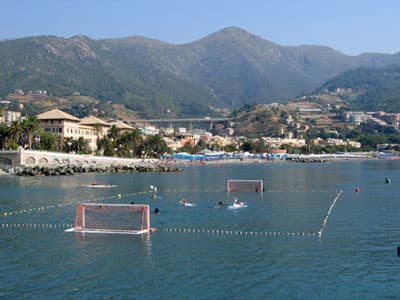Genoa and the Coast
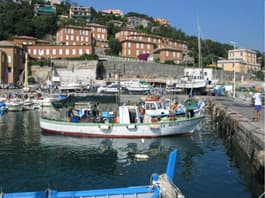 Santa Cruz, California, a major city on the shores of Montery Bay National Marine Sanctuary has a sister city relationship with Sestri Levate, in the region of Liguria, in Italy. Genoa, the capital city in that region, and Sestri Levate have had many emigrants to Santa Cruz over the past 100 years.
Santa Cruz, California, a major city on the shores of Montery Bay National Marine Sanctuary has a sister city relationship with Sestri Levate, in the region of Liguria, in Italy. Genoa, the capital city in that region, and Sestri Levate have had many emigrants to Santa Cruz over the past 100 years.
Genoa has a long lineage of sailors, fishermen, explorers, and maritime industry. Most school children learn that Christopher Columbus was born in Genoa Italy, although sailed under the flag of Spain. Today it boasts the most visited aquarium in Europe and the largest intact historical center.
Liguria is a narrow coastal region that stretches from the Italy-France border near San Remo in an arc to the east as far as La Spezia and the coast of Tuscany. The region, which more than any other in Italy resembles coastal California with its coastal mountain ranges, intermittent rocky and sandy beaches, and in places pine trees or palm trees on the coast, is the birth place of pesto.
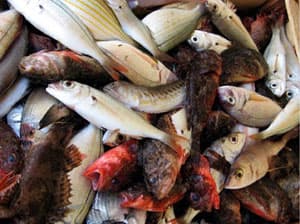 Genoa
is one of the most multi-faceted large ports in the world, being fully
engaged in commercial fishing, industrial maritime shipping, cruise
ships, coastal and international ferries, an international airport,
and tourism. The Genoa Aquarium is the center of a busy area of
the historical port, Porto Antico. Resembling Boston's harbor
and the New England Aquarium, much of the area around the Genoa Aquarium
continues to be redeveloped. For instance, former cotton warehouses
now function as a convention center, restaurants, a multi-plex theatre,
museums, and a swimming facility. Also along the harborfront are
a museum of the Antarctic, a children's exploration center and
a maritime museum.
Genoa
is one of the most multi-faceted large ports in the world, being fully
engaged in commercial fishing, industrial maritime shipping, cruise
ships, coastal and international ferries, an international airport,
and tourism. The Genoa Aquarium is the center of a busy area of
the historical port, Porto Antico. Resembling Boston's harbor
and the New England Aquarium, much of the area around the Genoa Aquarium
continues to be redeveloped. For instance, former cotton warehouses
now function as a convention center, restaurants, a multi-plex theatre,
museums, and a swimming facility. Also along the harborfront are
a museum of the Antarctic, a children's exploration center and
a maritime museum.
The
Genoa Aquarium, like the Monterey Bay Aquarium and other successful aquaria
in the world, concentrates on the local species around the aquarium,
in this case the Mediterranean Sea (http://www.acquario.ge.it/). It
also houses other diverse exhibits such as one on the fish and invertebrates
of the Antarctic, hummingbirds, evolution, and a recently opened exhibit
on marine protected areas. Perhaps most in common with the Monterey
Bay Aquarium, the Genoa Aquarium focuses on creating an awareness and
constituency for ocean literacy and sustainable coastal living. It
too has an advanced science program that concentrates on seagrass science
and restoration, marine protected areas around Europe and Africa, dolphin
research and 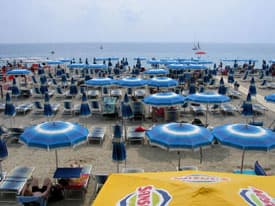 reducing the effects from human activities that can harm
the environment such as fishing, boating and diving. Throughout
Liguria and much of Italy, the coastline is heavily used. In
August, nearly 70% of Italians who go on vacation go to the coast and
ocean for at least part of their vacation. Italian coastal communities
typically lease the beaches to commercial vendors who sell access to
the sand and surf. Beachgoers in Italy are willing to pay up to
the equivalent of $40 per day for two people and a beach chair and umbrella. For
a month at the beach, which is a common vacation in Italy, the beach
access alone can typically cost $1,200 depending on amenities, much more
if one rents a "cabin" to store towels, sandals and sunscreen. The
sand on the "paying beaches" is usually the best a town has
to offer, and are beautifully maintained with trash removed each day. The "public
beaches", often small and rocky, get a great deal of use and have
crowds who can overrun facilities such as trash cans.
reducing the effects from human activities that can harm
the environment such as fishing, boating and diving. Throughout
Liguria and much of Italy, the coastline is heavily used. In
August, nearly 70% of Italians who go on vacation go to the coast and
ocean for at least part of their vacation. Italian coastal communities
typically lease the beaches to commercial vendors who sell access to
the sand and surf. Beachgoers in Italy are willing to pay up to
the equivalent of $40 per day for two people and a beach chair and umbrella. For
a month at the beach, which is a common vacation in Italy, the beach
access alone can typically cost $1,200 depending on amenities, much more
if one rents a "cabin" to store towels, sandals and sunscreen. The
sand on the "paying beaches" is usually the best a town has
to offer, and are beautifully maintained with trash removed each day. The "public
beaches", often small and rocky, get a great deal of use and have
crowds who can overrun facilities such as trash cans.
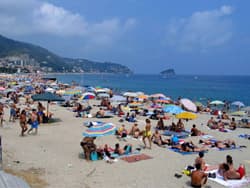 But
Italian love of the ocean creates many opportunities for use of the ocean.
Many coastal areas in Liguria have ocean water polo "parks".
Sailing and recreational boating are popular. Scuba diving is
popular and growing. And while recreational fishing is no longer
a large business in Italy, commercial fishing in small vessels continue
to harvest the ocean, although fishermen struggle in Italy as they
do in other countries.
For
this reason, many Italian fishermen have begun to embrace marine protected
areas as an opportunity to increase the size of fish caught near them. Many
of the Italian MPAs also include provisions that allow only local fishermen
(fishermen who have lived their entire life in a city and fish from one
port with small vessels) to fish in Zone B or Zone C. These measures
assure that the local fishermen, who feel they will sacrifice when zones
are put in, will get the spill over benefits when the zone begins to produce
larger and more fish in the future. The MPAs in Italy are not without
controversy, and several are still embroiled in controversy many years
after zones are established.
But
Italian love of the ocean creates many opportunities for use of the ocean.
Many coastal areas in Liguria have ocean water polo "parks".
Sailing and recreational boating are popular. Scuba diving is
popular and growing. And while recreational fishing is no longer
a large business in Italy, commercial fishing in small vessels continue
to harvest the ocean, although fishermen struggle in Italy as they
do in other countries.
For
this reason, many Italian fishermen have begun to embrace marine protected
areas as an opportunity to increase the size of fish caught near them. Many
of the Italian MPAs also include provisions that allow only local fishermen
(fishermen who have lived their entire life in a city and fish from one
port with small vessels) to fish in Zone B or Zone C. These measures
assure that the local fishermen, who feel they will sacrifice when zones
are put in, will get the spill over benefits when the zone begins to produce
larger and more fish in the future. The MPAs in Italy are not without
controversy, and several are still embroiled in controversy many years
after zones are established.
